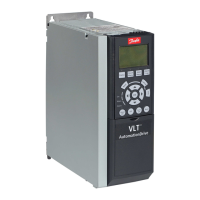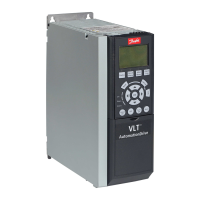FC 300 Design Guide
Introduction to FC 300
" Control with Brake Function
The brake is to limit the voltage in the interm ediate circuit when the motor acts as a generator.
This occurs, for e xam p le, w hen the load drives the m otor and the power accumu lates on the DC
link. The brake is bu ilt up as a chopper circuit with the connection of an external brake resistor.
Placing the brake resistor exte rnally offers the following advantages:
- The brake resistor can be selected on the b a sis of the app lication in question.
- The braking energy can be dissipated outside the control panel, i.e., where the energy can be utilized.
- Theelectronicsoftheadjustablefrequencydrivewillnotoverheatifthebrakeresistorisoverloaded.
The brake is protected against short- circuiting of the brake resistor, and the brake transistor is monitored t o
ensure that short-circuiting of the transistor is detected. A relay/digital output can be used for prote cting
the brake resistor against overloading in connection with a fault in the adjustable frequency
drive.
In addition, the brake makes it pos sible to r ead out the momentary power and the mean power
for the last 120 seconds. The brake can also monitor the power energizing and make sure it does
not exceed a limit s et in par. 2-12. In par. 2-13, select the function to carry out when the powe
r
transmitted to the brake r esi stor exceeds the limit set in par. 2-12.
NOTE
Monitoring the braking energy is not a safety function; a therm al switch is required for
that purpose. The brake resistor circuit is not ground leakage pro tected.
Over-voltage control (OVC) (excluding the brake resistor) can be select
ed as an alternative brake function
in par. 2-1 7. This f unction is active for all units. The function ensures that a trip can be avoided if the
DC link voltage increases. This is done by increasing the output frequency to limit the voltage from
the DC link. It is a very useful function, e.g., if the ramp-do
wn time is too short since tripping the
adjustable frequency drive is avoided. In this si tuation, the ramp-down time is extended.
49
MG.33.B6.22 - VLT is a registered Danfoss trademark

